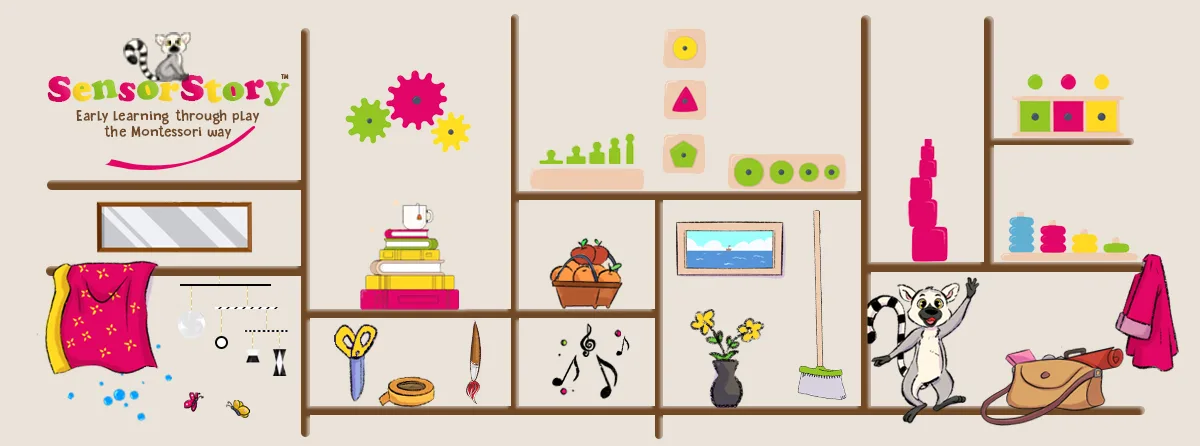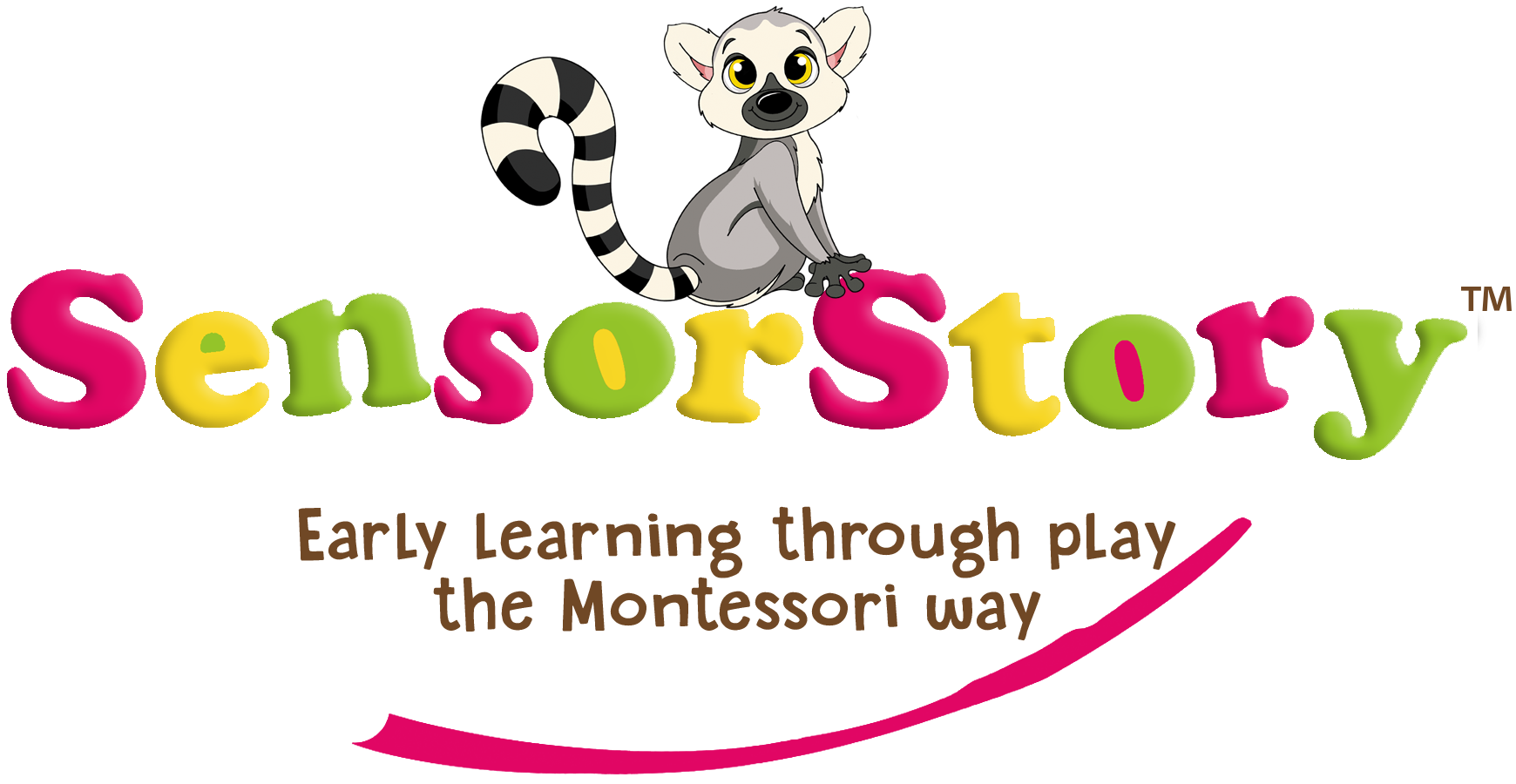We've put together a detailed list of at-home Montessori-aligned activities suitable for a 9-month-old.
Here you will see age-appropriate activities for all areas, in our Ultimate Series Of Activities to try at home, where the emphasis is on providing a prepared environment and allowing the child to actively engage in self-directed learning.
So what is my child working on mastering at this age?
Between the 9-12 month age, typically we will see your little one focused on sensorimotor exploration, refining gross and fine motor skills, early language development, fostering independence in simple tasks, and establishing a sense of order and routine in their environment.

1. Sensory Exploration:
* Allow your baby to experience different temperatures by offering warm or cool materials.
* Offer baby different sensory materials to explore, such as water, sand, playdough, or rice. You can use a large tray or a tub to contain the materials and provide some tools for scooping, pouring, or molding. This will help baby develop fine motor skills, hand-eye coordination, and sensory awareness.
* Toy on a suction cup base: this is a sensorial material that can help baby develop fine motor skills, hand-eye coordination, sensory development, and problem-solving skills. You can attach any toy that is safe and interesting for baby to a suction cup base and offer it to them while they are sitting or in their high chair. They can bat, grab, and release the toy and watch it move.
* Observation: Observe your baby carefully and respectfully, without interrupting or distracting them, to learn about their needs, interests, and preferences.
2. Eye-Hand Coordination:
* Offer a set of soft building blocks for baby to grasp and stack, promoting fine motor skills.
* Provide a small bowl with large, graspable objects for transferring between hands.
* Introduce a simple cause-and-effect toy that responds to baby's touch.
* Wooden ring stacker: This is a classic Montessori material that consists of a vertical dowel and wooden rings of different sizes and colours. You can show baby how to take the rings off and put them back on. This will help baby develop fine motor skills, hand-eye coordination, as well as colour and size discrimination.
3. Movement:
* Use a soft ball for gentle rolling back and forth between you and your baby.
* Create a safe space with low furniture for baby to pull up and cruise.
* Provide a Montessori balance boards for baby to practice shifting weight.
* Using a shallow water basin, under close supervision allow baby to explore water with their hands and feet.
4. Practical Life Skills:
* Introduce wet pouring activities.
* Introduce the concept of wiping using soft baby wipes.
* Provide a child-size spoon and a small bowl for baby to practice scooping.
* Encourage self-feeding with age-appropriate finger foods.
5. Language Development:
* Read board books with large, beautiful illustrations and few words.
* Name everyday objects during routines, such as naming items during mealtime.
* Engage in interactive conversations by responding to the baby's babbling with enthusiasm.
* Engage in Baby Sign Language with your baby. Teach your baby simple signs like “more,” “all done,” and “milk” to help them communicate before they can speak. To learn more about using Baby Sign Langauge click here.
* Treasure basket of animals: fill a basket with 3 or 4 realistic animal figures (such as Schleich animals) and allow baby to explore them with their hands and mouth. This will help baby develop language, cognitive, and sensory skills.
6. Art Exploration:
* Create simple stamps using baby-safe materials like soft sponges or textured fabrics, encourage baby to press the stamps onto paper to explore patterns and textures.
* Offer non-toxic, washable finger paints for baby to explore colour and texture.
* Introduce large, easy-to-grip crayons for the baby to explore mark-making on paper.
* Allow baby to crumple and tear paper for a tactile experience.
* Add a small amount of paint to a sealable freezer bag and securely seal it. Allow baby to squish and move the paint around inside the bag.
* Create DIY sensory paints using safe ingredients like pudding or yogurt mixed with natural food colouring.
7. Music:
* Engage in gentle movement activities, such as swaying or bouncing to music.
* Introduce baby to simple musical instruments, such as shakers, bells, drums, or xylophones. You can show baby how to make sounds with them and then let them experiment on their own. This can help your baby develop auditory, rhythmic, and musical skills.
* Sing songs with repetitive actions, encouraging baby to mimic movements like clapping or waving. Read our article on the Benefits Of Music At Playtime here.
8. Nature Exploration:
* Create a nature-inspired sensory basket with safe items like pinecones, leaves, or fabric.
* Introduce wooden animal figures for gentle play and exploration.
* Soft outdoor blanket: use a soft blanket for outdoor play and relaxation.
* Encourgae your baby to feel grass or leaves during outdoor play.
9. Object Permanence:
* Wooden egg in a cup: This is an imbucare activity that involves placing a wooden egg inside a wooden cup. You can show baby how to take the egg out and put it back in. This will help baby develop hand-eye coordination, spatial awareness, and object permanence.
* Introduce nesting cups or containers for baby to explore opening and closing lids.
* Place a soft cloth over a toy and encourage baby to reveal it.
* Introduce soft books with fabric flaps that your baby can lift to reveal hidden pictures or objects.
* Place a soft toy inside a cloth bag and allow baby to explore reaching inside to retrieve it.
* Create a simple pop-up tent using soft fabric, allowing baby to enter and exit, experiencing moments of disappearance and reappearance.
10. Social Interaction:
* Arrange playdates with other babies for social engagement.
* Engage in interactive games, such as gentle clapping or patty-cake.
* Encourage mirrored play by imitating baby's expressions and sounds.
11. The Whole Child Development:
* Attend our weekly SensorStory Baby and Toddler Montessori parent-child sensory classes! Follow this link to enrol your infant here.
We hope we have given you some inpiration for activities to do with your 9-month-old!
Remember, follow the child, adapting activities based on your observation of your baby's developmental stage and individual interests. The key in a Montessori environment is to provide your child with real, purposeful, and age-appropriate tools and materials that allow them to engage in activities independently and at their own pace.
Disclaimer: Adult supervision is required for any activity suggested by SensorStory. Please follow any directions and/or warnings on the labels(s) of any materials used during such activity & be aware of any potential choking hazards or allergies.
Click here to see our
'Activities To Do With A 10 Month Old
FAQ.
